|
Akha/Igor
The
Akha are amongst the poorest of the
hill tribes in northern
Thailand and are known as Igor by the Thai. They
originate principally from
Yunnan and are
related to the
Hani there. There
are various subgroups including the Yi or Lolo, with a
language derived from the Tibetan-Burman linguistic group. They have no written language and
depend solely on oral tradition. They began to migrate to Thailand, about one
hundred years ago, and like the U Lo and the Loimi (fig.), the
two main
groups in Thailand, they are originally from
Burma.
The subgroups can be differentiated by the women's headdress, which is
unique for each group.
_small.jpg)
They usually live high in the mountains where, until
recently, they were engaged in the cultivation of
opium. After a ban on opium, most
of them with government support, turned to other crops.
Originally the Akha were an
animist
people.
Their religion, called the Akha Way, consisted mainly of ancestral worship and a belief in spirits. Today almost a quarter of them are
converts to Christianity, which is seen as a modern version of the
Akha Way and sometimes co-exist with their animist beliefs and practices.
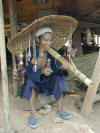
Still seen today, is
the typical spirit gate (fig.) on each side of an Akha village.
It separates the human world from the one of the bush spirits, and protects
against them. Each year, at the beginning of the rice planting season, the villagers
install new gates and decorate them with several objects to scare away
evil spirits. These objects are often valuables or symbols of human wealth, amulets and
carvings of naked or copulating humans
(fig.);
such things are feared by the spirits living in the forest. Typically in Akha villages is a giant wooden swing
(fig.)
used by the villagers to celebrate the harvest
literally by singing and swinging.
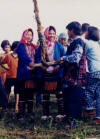
The traditional male
attire is, nowadays, usually preserved for special festivities, but Akha people are
easily recognized by their unique features and physiognomy
(fig.).
They
often
wear topknots (fig.) and may occasionally be seen with very particular
hats. The female dress is
clearly the most impressive amongst the hill tribes, particularly the imposing headdres. From an early age girls
first wear a colourful bonnet on
which ornaments, such as silver coins, coloured fur, shells and beads are added
until they reach adulthood. Eventually they are given a helmet type headdress for adult women
(fig.)
after undergoing several important rites.
Some say it
is Akha custom that the male buys the woman's
headdress
for his future wife and that once she puts it on,
she has to wear it for the rest of her life. According to the
subgroup they belong to this
headdress differs: the Loimi Akha (fig.) wear a hat with silver balls and coins in
the front and a silver plate at the back (fig.).
The silver balls are also made from coins, which are hammered into thin
hemispheres using a mould, which are then joined together into hollow
balls. The U Lo Akha (fig.)
on the other hand wear a conical bonnet with coins and colourful coils of fur,
whilst others might have just a scarf.
The
largest headdress among the Akha is that of the so-called Pahmi (fig.).
It consists of a large flap decorated with silver pins, which
has a plate at the back and on the sides has horse
flap-like covers, which are overall red in colour and decorated with
silver coins and some other silver jewelry. This enormous headdress also
has several strings of beads in different colours (fig.). The Akha headdress is
worn by the women at all times, i.e. not just at ceremonies, though when
working in the field some might at times wear just a
scarf.
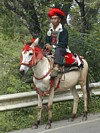
The
calves of the women are cloaked
in dark blue puttees
and from their waist hangs a short black knee-length skirt, flat in
front and pleated at the back. Around the waist they sometimes wear a broad
colourful sash, with one end hanging in front of the skirt. A
shawl,
is sometimes worn with a single
ribbon
covering the
torso
from above the breast to the
navel
(fig.) and on top of this they may wear a
long sleeved waist-jacket. The jacket as well as the shawl
and leggings are often decorated with
colourful embroidery. Today, the Akha in Thailand also have their own flag (fig.).
TO LEXICON.
回

Karen/Nyang
With around
265,000 the
Karen are the largest hill tribe in Thailand. They have lived in the region for many
centuries and are divided into several subgroups, of which the most numerous
in Thailand are the
Sakoh (Sgaw),
Pwo
and
Kayah,
besides the
Kayang and
Padong,
both
Long-neck Karen, and the
Kayaw,
a smaller subgroup whose women are typified by their long earlobes (fig.). The word
‘Karen’ is not
known to the different subgroups themselves and the Thais call them
Kariang and
Nyang.
The term is however generally used by anthropologists when referring to certain tribes who
speak closely related tongues but are not closely related to the languages of other
hill tribes. They are therefore placed in a separate category within the Tibetan-Burmese
family of the Sino-Tibetan language group.
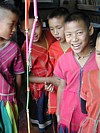
Prince
Kawila integrated a large number of them into the
local population of
Chiang Mai when he re-populated the city. The majority
of Karen nowadays live in
Mae Hong Son and
Chiang Mai, but they are also found
in
Phrae,
Chiang Rai,
Lampang,
Tak
and
Kanchanaburi. In
Burma
there are approximately four
million.
A considerable number of
the
Karen are Christian or
Buddhist and the first Karen script was developed in 1832 by a Christian
missionary in Burma. Karen villages are seldom high in the mountains and the men
are often skilled
mahouts
(fig.),
perhaps a reason why the name Karen is related to the Sanskrit word for
elephant, i.e.
karin.
They are also often physically attractive and of a cheerful disposition.
The
traditional male attire is usual a red sleeveless shirt with v-shaped neck.
The women wear a similar shirt of a darker colour
(fig.)
over a long red sarong of which the texture indicates to which clan they
belong. Young girls wear a long white skirt in a similar shape as the shirt but
reaching to the ankles and trimmed with a pink band (fig.).
The women
belonging to the
Long-neck Karen (fig.)
wear a similar though shorter version of this girls garment, and on top of a
black
sarong.
The female Long-neck Karen wear blue puttees on their calves, underneath
brass rings. They also wear brass rings around their arms and usually have a
coloured scarf. Other
Karen women usually wear a turban-like headdress.
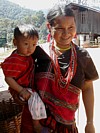
One of the subgroups of the Long-neck Karen in Thailand,
the Kayan or Kayang, who originally came from Burma, live today mainly in the provinces of
Mae Hong Son and Chiang Rai, close to the border with
Myanmar.
Their name also refers to their language. Their women's traditional
costume includes the wearing of brass coils. After 1000 AD the Kayang people dealt economically and socially with the neighbouring
Shan
and the women were often seduced by these outsiders. Then the
Pwo
from the
Thaton region alerted the Kayang that about atrocities the Burman people had inflicted upon
them, so the Kayang started to look for a solution on how to avert
these threats.
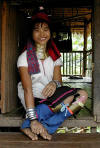
Since they are descendants from
Lan Nan
Htu Su and
Ka Kwe Bu Pe,
they decided to institute a status symbol for their women. According
to
folklore, when the girls Mu Don and Mu Dan visited their
grandmother, the lady dragon, they were presented with gold bars
when they left. They then started to decorated themselves by winding
gold coils around their wrists and necks. As gold was rare the need
for brass arose. This was obtained by exchanging silver with the
Shan traders, mainly provided by those of the Satoung village. Since
1070 AD the Kayang women have worn brass coils. There are several
reasons for wearing them e.g. to avoid an unwelcome advance by the
Shan and Burman chiefs; as cultural identity and to distinguish
themselves from other ethnic groups and protect the women from
intermingling with other races; and as a status symbol, as they are
descendants of the mother dragon they adorn themselves in her
likeness, with the idea that how longer the neck is, the more
graceful the looks are.
The Kayang Long Necks start wearing brass
coils from the age of four. From then onward the rings are changed about twice
until the age of fourteen, with loops being added to the spiral about every
three years, as the girl grows and ages. Brass coils for adults usually consist
of multiple parts that is, a main coil of 16-22 (max. 25) windings, with at the base a
separate 5-6 coil winding, onto which a smaller coil of 62 mm diameter with 5
loops is attached perpendicularly, at the back.
_small.jpg)
Each set of brass rings is made in one piece from a single brass rod
and a total set of rings for adults can easily weigh up to 8 kilos,
depending on the size and number of coils. The men prepare the brass rods but
it are the women who fix the rings. Brass is a tough metal and the
winding is done manually by any strong woman with exceptional talent,
called a fixer. Besides the side affects of flesh wounds, wearing
the brass coils may over time result in pains in the shoulders
and displacement of the collar bone, as due to the permanent weight
of the brass, the collar bone is pushed down and compresses the rib
cage. But still, most woman want to wear their brass, even after
death. For example, brass coils removed during illness have to be
reinstated after death and if this is not possible the brass must be
placed in the coffin. However, some women hand their brass coils
down to their granddaughters, in the manner as the lady dragon
presented her granddaughters with gold.
Apart from being an
adornment, the brass rings also have a practical use, serving as a
treasury where banknotes are kept, stuck away between the neck and
the rings. There are however also many incorrect rumours about the
Long Neck women, not based on facts, e.g. that a new ring is added
every year (untrue: that's only with trees!); that the rings protect
against
tiger
bites (untrue: have you
ever been bitten by a tiger? - don't think the rings will save
you!); that the rings are made of pure gold (untrue: according to
folklore that's how it began, but if it would be true today, that
would mean around five kilos of pure gold for every Long Neck woman
in the village - can't call that poor!); that if the rings are
removed the neck will break, resulting in certain death (true: every
death is certain, but untrue with regards to the neck and the rings, as they are removed
at times, during illness or when they are
replaced with a new or larger one - the long neck is just optical deception!); that all the women who wear the
brass coils were all born on a full moon [untrue: maybe they were
conceived on a full moon?! :) ].
The Kayang religion, in
which they worship the
Kan Thein Bo pole, is called
Kan Khwan. Besides the
Kayang also the Ndebele tribe of South Africa and the Dimeka tribe
of Ethiopia wear brass coils around their neck. The Kayang are also called Kayan.
TO LEXICON.
回
Lahu/Mussur
The
Lahu
are a hill tribe of whom the majority
lives in the northern Thai provinces
of
Chiang Mai and
Chiang Rai
(fig.). Emigrating
from Burma they settled in Thailand around the end of the 19th century.
Today they number around 60,000 and live
usually
in pile dwellings high up in the mountains (fig.).
They divide themselves into
subgroups
named after the main colour of their garment. Besides the
Red
Lahu (Lahu
Nyi), the
Yellow Lahu
(Lahu
Shi) and
White Lahu
(Lahu
Hpu),
there are two more subgroups
of
Black Lahu
(Lahu Na),
who
distinguish themselves
by
different
languages and
traditions, with one group
calling themselves
Laho
Na,
known to the others
as
Lahu
Shehleh.
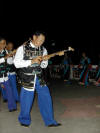
The female traditional attire of
the
Lahu Shehleh or
Lahu Na (also called
Mussur Dam) is a
long black silk-like gown, trimmed with white and sleeves with white, blue
and red bands
(fig.).
The male dress is a black pair of culottes sometimes trimmed with a blue
belt. Lahu
Nyi women wear a waist-deep
jacket sleeved with horizontal bands in namely red and blue.
Each
subgroup has its own dialect
belonging to the
Lolo branch of the Tibetan-Burmese language group, of which the
standard language
is
Lahu Na, a language also spoken by most
other Lahu people outside Thailand
(in Burma, Laos, Vietnam and
China) and which is close related to the language spoken by
the
Lisu.

The
Thai name for
this people is
Mussur and divides into
Mussur Daeng (Red Mussur),
Mussur Dam
(Black Mussur)
and Mussur Kwi,
of which the meaning is unknown.
Because many
Lahu are converts to
Christianity,
the
Thai also refer to them as Mussur Khrit (Christian
Lahu), although
they do worship
Ai-ma, the mother goddess of the earth, as well.
TO LEXICON.
回

Lisu/Liso
The
Lisu (Liso) are an formerly
animist
people with a
shaman-like
veneration of ancestors.
There are today around 25,000 Lisu in Thailand and many are converts to
Christianity. Their light skin and fair complexion gave them the
reputation to be the most beautiful amongst the hill tribes.
Until recently
the Lisu lived principally from
the cultivation of poppies but, after
a ban on
opium
imposed under pressure from the United States, crops were
destroyed and many of them became ruined. Most were able to swap to the
cultivation of other crops, but practiced slash and burn techniques
destroying many acres of forest for just a few crops. To make the same
profits as with opium much more land is needed. This in combination
with commercial logging
causes frequent landslides
and
floods in the rainy season, whilst
overproduction and low prices made the market plummet.
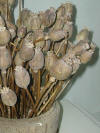
The language of the
Lisu belongs to the
Yi or
Lolo
branch of the Tibetan-Burmese
language group and probably originated in
Tibet, though the
core of the population lives mainly in the
North of the South-Chinese
province
Yunnan,
west of the
Salween
river.
This area is also home to the Yunnan Snub-nosed Monkey, a rare species of
monkey, which has inspired this tribe's legend, as the Lisu people believe it to be related to their ancestors,
and refer to it as the Wild Man of the Mountain.
From this province,
translated meaning the
‘Land under
the Cloud’,
they spread west, south and eastward, and partly entered
Thailand around
the
end of the
19th
century AD
via
Chiang Mai.
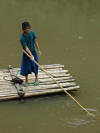
The female
traditional attire is a
loose
colourful apron-like skirt, often light green or sky blue, which in front
reaches
to the knees and in the back to the calves.
Its wide sleeves
usually reach no further than the lower arm
and are often bright red.
The
top
of the skirt is covered with colourful
embroidery and around the neck there is a black band ending in coloured stripes,
sometimes in bright contrasting colours.
Underneath the skirt they wear a wide black
pair of culottes reaching to just under the knees, and sometimes they have red
puttees around their calves. A waist belt holds the skirt up. During festivities and on special occasions, the girls and
women also wear a flat circular hat, which is adorned with beads and strings,
and topped with tiny pom-poms
(fig.).
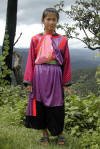
The men wear a
loose, bright blue pair of
culottes reaching to just below the knees, and a black jacket usually ornamented with
silver. They may also wear
black puttees. As many other hill tribes the Lisu people play their traditional
music on instruments made from natural products, such as bamboo (fig.). Today
Lisu women are more often seen in traditional dress than the men (fig.)
TO LEXICON.
回

Yao/Iu Mien
A hill tribe in
southern China and in northern Thailand, where they are called
(Iu)
Mien,
but by the Chinese and the Thais they are named after the language they speak, namely
Yao. In Yao language Mien means
‘people’, but in Laos
and
Vietnam they are called Man, an old Chinese word for ‘barbarian’ which also
refers to groups other than the
Iu Mien.
The Yao
language is part of the
Miao-Yao-Pateng
family, a subgroup of the Sino-Tibetan language group that also includes Chinese,
Burmese and Tibetan.
Members of the Iu Mien can often speak
Yunnan
Chinese, the language spoken in the
most southern province of
China, or the close related Mandarin. Being able to
read and write Chinese has always been held in high respect by the Iu
Mien. Their liturgical language is an old form of Chinese, comparable to
Pali in Buddhism, and
Chinese characters are also used writing Yao.
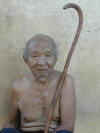
The Yao migrated to
Thailand during the 19th century encouraged by the trade in
opium and the retaliation of
the Chinese government as a result of local revolt in southern China during that
period. They entered Thailand through Laos in the late 19th century and settled
in the province
Nan,
and in what today is called
Phayao.
Large numbers came after World War II and settled mainly in and around
Chiang Rai.
Their total number in Thailand is
estimated at around 40,000 and their distinguished
religion is a mixture of
animism,
ancestral worship and
Taoism.

The
female
traditional
attire is loose pair of trousers and
a
dark blue almost black jacket embroidered at
the bottom and with a dark red pompom-like collar resembling a
stole. Their headdress consists of a dark
coloured angular hat, ornamented with embroidery.
They often wear a heavy silver ring around
their neck and children sometimes have a traditional cap with red pompoms.
The male attire consist of a dark blue to black pair of culottes and a loose
jacket in the same colour with a double
cuff (fig.).
In
China,
the Yao women of Jinxiu, in the Autonomous Region of Guangxi Juang, wear an
ensemble with silver adornments and cross-stitched embroidery (fig.).
In Vietnam, the Yao
are known as
Dao.
TO LEXICON.
回
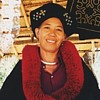
Hmong/Maew
The
Hmong
are a hill tribe people (fig.)
in
northern Thailand, who originated in either Tibet or Mongolia,
and of whom today around 5 million still live in
China
where they settled as
early as
4,000 years ago and are known as
Miao
(fig.). They are called
Maew
by the Thais and their
religion is a mixture of ancestral
worship, belief in spirits, and
Taoism.
Their
language belongs to the
Sino-Tibetan language group of the Miao-Yao-Pateng
family,
with several dialects. They settled in Thailand via Laos more than a century ago
and today their numbers is around 90,000 with the Blue Hmong
(fig.)
more living in the West, and the
Hmong Doew (White Hmong) more in the East of
northern Thailand, and there are also
Hmong in
Vietnam
(fig.).

Many Hmong
helped U.S. forces during the Vietnam War, fighting under CIA advisers
during the so-called Secret War in Laos, before it fell to the
communists in 1975. The Hmong claim they have been persecuted by the Lao
government ever since and many are known to have fled to Thailand
since 1975, though most were later either repatriated to Laos or
resettled in third countries.
The
Hmong are in many aspects similar to the Yao
or
Iu Mien.
The Blue Hmong call
themselves
Hmong Njua, what literally in their language actually means ‘Green’ Hmong. The women wear black jackets with
an embroidered collar (fig.)
and black puttees underneath a
pleated batik skirt reaching to the knees. Originally, their hair style is tufted.

White Hmong on the other hand,
are called white, because their women traditionally wore white dresses, though
today they also
wear a black
pair of trousers underneath a long apron hanging over the shoulders to the front
and back, and kept together with a red to orange piece of cloth tied around
their waist with a silver belt. They also, wear their hair in a tuft or, cover
their heads with a small conical hat. From the back of their jackets hangs a
large rectangular and colourful piece of cloth, like a flap.
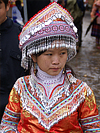
Hmong boys
and men
wear a short black waist-deep jacket with a double cuff, of which the outer one
is usually a large embroidered flap. Their trouser are like a black pair of
culottes, akin to those of the
Hmong Njua
(fig.).
In
Vietnam (fig.), the main subgroups are the Black Hmong (fig.)
and
Flower Hmong (fig.),
as well as the Blue Hmong (fig.),
the Green Hmong (fig.)
and some White Hmong (fig.).
TO LEXICON.
回 |